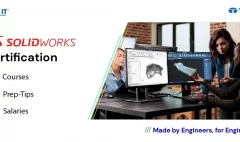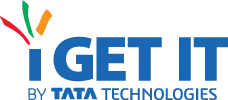Most Common GD&T Interview Questions & Answers [Expert’s List]
October 18, 2024 2024-11-11 13:13Most Common GD&T Interview Questions & Answers [Expert’s List]
Most Common GD&T Interview Questions & Answers [Expert’s List]
In today’s manufacturing and engineering world, precision is crucial, and Geometric Dimensioning and Tolerancing (GD&T) plays a vital role in ensuring that parts fit and function perfectly. Mastering GD&T interview questions and answers is essential for anyone looking to stand out in this field. This guide will help you prepare by exploring key questions that demonstrate your expertise and readiness for real-world engineering challenges. Let’s dive into the critical principles that will set you apart in your next interview.
Table of Contents
Despite years of hands-on experience, the pressure I face during GD and T interview process was intense, pushing me to apply not just theoretical knowledge but real-world problem-solving skills under pressure. The GD&T concepts, I had used in daily projects suddenly felt like a test of my understanding, and I had to prove that I could translate that knowledge into precise, actionable decisions. It was a humbling experience, but it helped me realize just how crucial thorough preparation is for excelling in such interviews. This interview questions list is crafted from that experience to help you confidently tackle the interview questions on Geometric Dimensioning and Tolerancing.
Basic Level GD&T Interview Questions
Here is the list of basic level GDandT Interview questions and answers for freshers:
1. What is GD&T?
Answer: GD&T stands for Geometric Dimensioning and Tolerancing, a system used to define and communicate engineering tolerances through symbolic language on technical drawings.
2. Why is GD&T important?
Answer: GD&T is crucial for ensuring that parts fit and function correctly by controlling variations in size and geometry. It enhances communication and minimizes ambiguities in engineering designs.
Also Read: What is GD&T and Why it is Important detailed blog
3. What are the basic elements of GD&T?
Answer: The core elements of GD&T include symbols, feature control frames, datums, and tolerance zones.
4. Explain the term “Datum” in GD&T.
Answer: A datum is a reference point, line, or surface on a part used for measurement. It serves as a starting point for the geometric control of a part.
5. What is a feature control frame?
Answer: A feature control frame is a rectangular box that contains information about a feature on a part.
Intermediate Level GD&T Interview Questions
Following are the intermediate level Interview questions on GD&T. It is likely to be asked by the interviewer at time of experienced professional interview.
6. What is the difference between MMC and LMC?
Answer: MMC (Maximum Material Condition) is the condition of a part feature containing the maximum amount of material. LMC (Least Material Condition) is the condition when the part feature contains the least amount of material.
7. Explain the term “True Position”.
Answer: The theoretical exact center of a feature like a hole or slot is represented by the true position.
8. What is the main importance of using datums in GD&T? Datums provide a common
Answer: reference for measurements, ensuring consistency in manufacturing and inspection processes. They help in aligning parts and ensuring proper assembly.
9. What is the main difference between tolerance and allowance? Tolerance is the permissible
Answer: variation in a dimension, while allowance is the intentional difference between the maximum material limits of mating parts to ensure proper fit.
10. Describe the concept of concentricity in GD&T.
Answer: Concentricity ensures that the centre of all diametrically opposed patterns of a rotating pattern coincides with the axis.
11. How is circular runout different from total runout?
Answer: Circular runout controls the variation of a feature at a specific cross-section, while total runout controls the variation over the entire surface.
12. What is profile tolerance?
Answer: Profile tolerance controls the profile or shape of a surface, ensuring it fits the specific profile within a tolerance range.
13. Explain the term “Flatness” in GD&T.
Answer: Flatness ensures that all points on a surface lie within two parallel planes, controlling the waviness of the surface without referencing any other feature.
14. What is the significance of the symbol “Ø” in GD&T?
Answer: The “Ø” symbol denotes a diameter, indicating that the tolerance zone or dimension applies to a cylindrical feature.
15. Describe the term “Parallelism” in GD&T.
Answer: Parallelism ensures that two surfaces or features are equidistant at all points, maintaining parallel orientation to a datum plane or axis.

Advanced Level GD&T Interview Questions
Here is the list of GD&T interview questions and answers for experienced professionals. Difficulty level is moderate-to-high.
16. How do you interpret composite tolerance in GD&T?
Answer: Composite tolerance controls multiple geometric characteristics simultaneously, allowing for complex tolerance zones and higher precision.
17. What is the role of tolerance stack-up analysis in GD&T?
Answer: Tolerance stack-up analysis evaluates the cumulative effect of individual tolerances in an assembly, ensuring the final product meets design requirements and functions properly.
18. What is “Form Tolerance” in GD&T.
Answer: Form tolerance controls the shape of a feature without considering its orientation or location, including aspects like straightness, flatness, circularity, and cylindricity.
19. Explain the difference main between unilateral and bilateral tolerances?
Answer: Unilateral tolerances allow variation in one direction from the nominal dimension, while bilateral tolerances allow variation in both directions.
20. Describe the significance of “Angularity” in GD&T.
Answer: Angularity controls the angle between a feature and a datum, ensuring the feature remains within a specified angle tolerance relative to the datum.
Practical Application Interview Question on GD and T
21. How to the apply GD&T in CAD software?
Answer: Applying GD&T in CAD software involves selecting appropriate symbols, defining datums, and assigning tolerance values to features based on design requirements.
22. What are common mistakes to avoid when using GD&T?
Answer: Common mistakes include incorrect datum selection, setting overly tight tolerances, and misunderstanding symbols and their manufacturing and inspection implications.
23. How does GD&T improve manufacturing efficiency?
Answer: GD&T enhances manufacturing efficiency by providing clear tolerancing information, reducing rework, and ensuring consistent quality in production.
24. What is the role of inspection in GD&T?
Answer: Inspection involves measuring and verifying that manufactured parts meet specified geometric tolerances using tools like CMMs, calipers, and micrometers.
25. How do you handle tolerance conflicts in GD&T?
Answer: Tolerance conflicts can be resolved by reviewing the design intent, consulting with the engineering team, and adjusting tolerances to ensure manufacturability and functionality.
Real-World Scenario GD and T Interview Questions
26. Describe a situation where you used GD&T to solve a manufacturing problem.
Answer: In a previous role, GD&T principles helped identify and correct misalignment issues, ensuring parts fit together correctly and functioned properly.
27. How do you ensure compliance with GD&T standards in a multi-national company?
Answer: Compliance is ensured by establishing standardized GD&T practices, training employees, and regularly updating procedures to align with international standards.
28. What are the challenges you faced while implementing GD&T in projects?
Answer: Challenges include resistance to adopting GD&T over traditional methods, the need for extensive training, and ensuring team members correctly apply GD&T principles.
29. How do you communicate GD&T requirements to suppliers?
Answer: Effective communication includes providing detailed diagrams of GD&T symbols, providing guidance on their interpretation, and working with vendors to ensure understanding.
30. What tools and technologies do you use to apply and verify GD&T in your work?
Answer: Common tools include CAD software for design, CMMs for inspection, and specialized software for tolerance stack-up analysis and simulation.
Final Note
Preparing for a GD&T interview can feel daunting, but with the right mindset and thorough practice, it becomes an opportunity to showcase your engineering expertise. Just like in my own journey, where every interview challenge became a stepping stone toward mastering the subject, you too can transform this experience into a moment of growth. The key is not just memorizing terms but understanding how to apply them to solve real-world problems. By familiarizing yourself with these GD&T interview questions, you’re already on the path to confidently stepping into your interview, ready to prove your skill and precision as a design engineer. Every question is a chance to demonstrate how deeply you understand the intricate language of engineering and manufacturing
GD&T Courses and Certifications by Tata Technologies
i GET IT by Tata Technologies training programs are designed to provide you with hands-on experience, expert insights, and the confidence you need to excel in your career. Equip yourself with the tools to not only answer interview questions but to thrive in your engineering role.
Start your journey today and unlock the full potential of your engineering career!
GD&T CoursesRequest InfoManjunath
Related Posts
SOLIDWORKS Certification: Top Courses, Prep Tips & Salaries
Top Automotive Design Engineer Courses by Tata Technologies
PLM Teamcenter Interview Questions and Answers – [HR Expert List]
Hybrid Electric Vehicles Webinar With Kedar Gokhale
Best EV Online Courses with Certification by Tata Technologies
Find
Categories
Latest Posts
Independent Front Wheel Suspension – Types, Benefits & Working
November 10, 2025What is PLM? – Product Lifecycle Management [Detailed Guide]
October 9, 2025Popular Tags



















